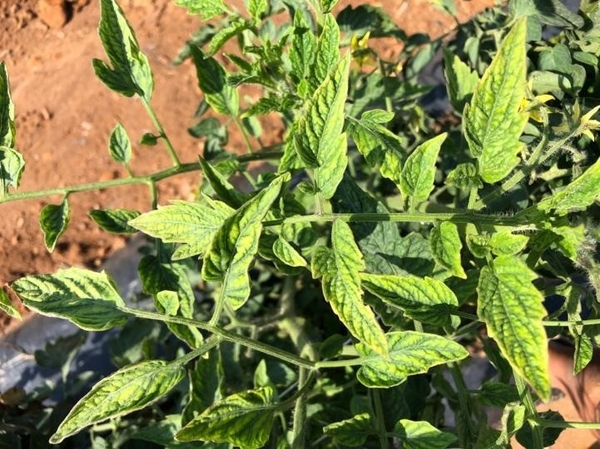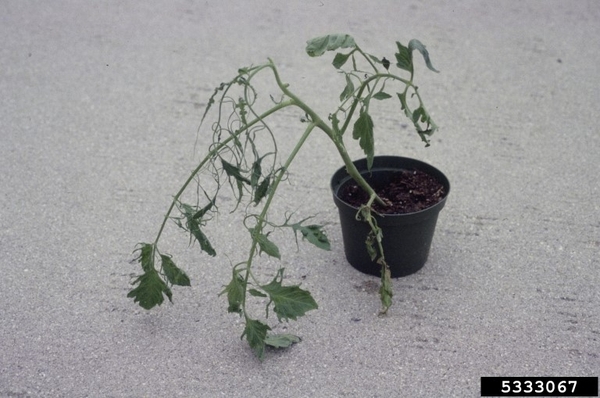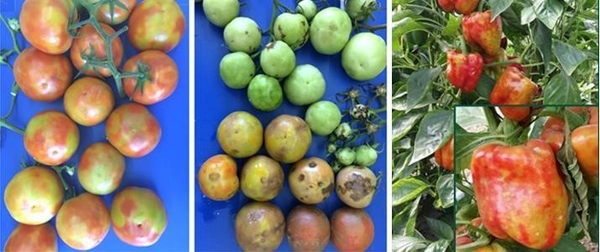General Information
The discovery of tobacco mosaic virus (TMV), the first virus ever identified, marked the beginning of the field of virology. After a major disease outbreak devastated tobacco crops in the mid-1800s in Europe, plant pathologists endeavored to identify the causal agent. In 1898, Martinus W. Beijerinck discovered that the pathogen was neither a fungus nor a bacterium but a different kind of pathogen altogether that could only replicate within the living cells of host organisms, which he called a “virus.” The discovery of the virus was groundbreaking in the field of plant pathology and the medical sciences and greatly advanced our understanding of plant disease.
In the early 1900s, Tobacco mosaic virus (TMV) and Tomato mosaic virus (ToMV) were major threats to the tobacco and tomato industries. Fortunately, today, resistant cultivars and an understanding of the importance of clean seed have minimized the spread of these viruses. It is still vital, however, to understand how to identify, prevent, and manage these viruses, as these highly infectious and persistent pathogens can lead to a major loss in crop yield and quality for growers. This article will discuss TMV and ToMV together because they are genetically similar, and their attributes, such as hosts, symptoms, and management strategies, vary slightly.
Tomato brown rugose fruit virus (ToBRFV) is a recently emerging tobamovirus similar to TMV and ToMV. It was first discovered in Israel in 2014 and has since spread to Mexico, the US, and several countries in Europe and Asia, however, it is not yet widely distributed in the US but has been introduced to operations via contaminated seed.
Pathogen
All three viruses are members of the genus Tobamovirus. ToMV is a specific strain of TMV that primarily infects tomato plants. Virus particles, called virions, are rod-shaped and measure 18 x 300 nm. Each rod contains a single strand of RNA enclosed by a coat of protein. The viruses infect the plant by entering microscopic wounds in the plant cells. TMV and ToMV can survive in infected plant debris such as leaves and roots and are able to remain dormant for up to two years, depending on the temperature and moisture level of the soil. ToBRFV is closely related and can also survive in soil and plant debris for long periods of time.
Host Plants
TMV commolnly infects tobacco while ToMV commonly infects tomato;, however, both viruses have a wide host range of over 200 species of herbaceous plants. Other common hosts include plants in the Solanaceae (pepper, eggplant, potato) and Cucurbitaceae (squash, pumpkin, cucumber) families, as well as ornamentals like begonia, verbena, geranium, and petunia. Due to the availability of resistant crop varieties, only 1% of tobacco crops and about 20% of tomato crops are affected each year. ToBRFV also has a wide host range of over 40 species in the Amaranthaceae, Apocynaceae, Asteraceae, and Solanaceae families. However, the only two major crops ToBRFV is known to affect are tomatoes and peppers.
Favorable Environmental Conditions
Temperatures around 24°C (75°F) favor the development of TMV and ToMV. Symptoms tend to be milder at higher temperatures. Specific environmental conditions that promote the development of ToBRFV are mostly unknown, but all tobamoviruses are known to spread most rapidly in areas where plants are grown at a high density, such as in greenhouses.
Symptoms and Signs
TMV, ToMV, and ToBRFV rarely cause the entire host plant to die, but the viruses can greatly reduce fruit quality and yield. Symptoms of these viruses vary depending on stage of infection, host plant, strain of virus, and environmental conditions. The most distinct symptoms are mottled leaves (Figure 1), which have blotchy light and dark spots (mosaic pattern). New growth and host plants infected at a young age may be stunted and chlorotic. Leaves of infected tomato plants tend to develop yellow streaks or spots, and may be malformed (Figure 2). Tomato fruit may ripen unevenly, resulting in deformation with rugose or wrinkled appearance (especially so with ToBRFV), and have brown spots and/or ringspots (Figure 3) causing the fruit to be unmarketable.
Disease Cycle and Epidemiology
All three viruses are highly infectious and can be easily transmitted from contaminated transplants, seeds, tools, grafts, sap, and most commonly, the hands of workers. Though the viruses are not typically transmitted by insects, they could potentially spread through insects that have fed on infected plants. These particularly hardy viruses can remain dormant in plant debris and soil for long periods of time and can infect other host plants well after the initial host plant has died. Environmental conditions dramatically affect the ability of the viruses to remain dormant and infectious. For example, ToMV can survive in leaf debris in dry soil for up to two years, whereas in moist soil the virus remains infectious for only up to one month.
General Disease Control
There is no cure for plants infected with viruses and there are currently no chemical treatments. Preventive and cultural management practices are therefore necessary to reduce the spread of TMV, ToBRFV and ToMV. Tomato growers should practice the following control measures.
- Sanitize all tools, equipment, and work surfaces before planting.
- Discard all infected plants, contaminated soil, and dead leaves as TMV can remain dormant and infectious in plant and soil debris.
- Rotate crops susceptible to TMV, ToBRFV and ToMV with crops resistant to the viruses, or non-host plants.
- Use resistant tomato varieties. Tomato cultivars resistant to TMV and ToMV currently available contain the Tm-1, Tm-2, and Tm-2² resistance genes (Table 1). Efforts are underway to identify cultivars resistant to ToBRFV, but there are currently no resistant varieties currently commercially available.
Reduce weeds in and around the field or greenhouse as they may harbor the viruses.
|
Fruit Type |
ToMV Resistant Variety |
TMV Resistant Variety |
| Slicer | Applegate F1 | BHN-589 F1 |
| Arbason F1 | BHN-871 F1 (yellow/orange) | |
| Beorange F1 | BHN-964 | |
| BHN-589 F1 | Big Beef F1 | |
| BHN-871 F1 (yellow/orange) | Big Beed Plus F1 | |
| Big Beef F1 | Big Bunch F1 | |
| Bigdena F1 | Bigdena F1 | |
| Bolseno F1 | Braveheart F1 | |
| Bolzano F1 | Brillante F1 | |
| Botero | Bush Early Girl II F1 | |
| Buffalo Steak F1 | Caiman F1 | |
| Carina F1 | Celebration | |
| Celebrity F1 | Celebrity F1 | |
| Chef’s Choice (Red) | Celebrity Plus F1 | |
| Chef’s Choice (Yellow) | Celebrity Supreme F1 | |
| Climatar F1 | Cencara F1 (Saladette) | |
| Cobra F1 | Champion II F1 | |
| Enroza F1 | Chef’s Choice F1 (Pink) | |
| Fenda F1 | Chef’s Choice F1 (Green) | |
| Frederik F1 | Climstar F1 | |
| GinFiz F1 | Cobra F1 | |
| Kakao F1 | Country Taste F1 | |
| Katana F1 | Cubalibre | |
| Komeett F1 | Early Girl F1 | |
| Laguna Red F1 | Early Goliath | |
| Lemon Boy Plus F1 | Empire F1 | |
| Loki | Enroza F1 | |
| Lola F1 | Estiva F1 | |
| Lorenzo F1 | Geronimo F1 | |
| Maitai F1 | Goliath F1 | |
| Marmont F1 | Grandeur | |
| Marnouar F1 | Gurney Gir’s Hybrid | |
| Marsalato F1 | Heatmaster F1 | |
| Momotaro F1 | Hy-Beed 9904 F1 | |
| Mountain Gem | Italian Goliath F1 | |
| Orangaro F1 | Jetsetter F1 | |
| Park’s Season Starter F1 | Joker F1 | |
| Pink Cupcake F1 | Lola F1 | |
| Pink Wonder F1 | Marvori F1 | |
| Primo Red F1 | Old Fashioned Goliath F1 | |
| Purple Zebra | Pamella | |
| Rally F1 | Park’s Beefy Boy | |
| Red Boar F1 | Park’s Whopper Improved F1 | |
| Red Bounty F1 | Pick-A-Licious F1 | |
| Red Deuce F1 | Polbig F1 | |
| Red Morning F1 | Primo Red F1 | |
| Red Mountain F1 | Quali-T 23 F1 | |
| RuBee Dawn | Rebelski F1 | |
| RuBee Goddess | Red Deuce F1 | |
| RuBee Plus | Red Eclipse F1 | |
| RuBee Prize | Red Hero F1 | |
| STM8135 | Red Lizard F1 | |
| Think Pink | Red Morning F1 | |
| Tomimaru Muchoo | Roni F1 | |
| Torero F1 | Rugged Boy F1 | |
| Shady Lady F1 | ||
| Sophya F1 | ||
| Tough Boy F1 | ||
| Trust F1 | ||
| Ultra Sweet F1 | ||
| Ultrasonic F1 | ||
| Umamin F1 | ||
| Plum/Roma | Agro | Apero F1 |
| Barbarian (saladette) | Bellatrix | |
| BHN-783 (Roma Yellow) | Corleone F1 | |
| Cedro | Golden Rave F1 (Roma) | |
| Davinci (saladette) | Granadero F1 | |
| E1 Cid F1 | Gumboe F1 | |
| Finger Lakes Round Paste | Health Kick F1 (Roma) | |
| Golden Rave F1 (Roma) | Lizziebelle F1 | |
| Granadero F1 | Mochomo | |
| Hybrid 46 | Palomo F1 (saladette) | |
| Invincible | Pasta F1 | |
| Katya | Patty F1 | |
| Latino | Pony Express F1 (Roma) | |
| Pegaso F1 | Ravello | |
| Pomodoro Squisito | Rugby | |
| Pony Express F1 (Roma) | ||
| Pozzano F1 | ||
| Premio F1 | ||
| Red Anjou F1 | ||
| Red Head F1 (Saladette) | ||
| Red Scorpion F1 | ||
| Ribelle F1 | ||
| Roble | ||
| Samurai F1 | ||
| San Marzano 2 | ||
| Serengheti F1 (Roma) | ||
| Sunoma F1 (Saladette) | ||
| Tiren F1 | ||
| Valerio | ||
| Grape/Cherry | Amai | Amarillo F1 |
| Bellastar | Apero F1 | |
| Carina | Apple Yellow F1 | |
| Carmesin | Artemis F1 | |
| Chocostar | Bartelly F1 | |
| Conde | BHN-968 F1 | |
| Crimson Star | Camelia F1 | |
| Dolce Vita F1 | Chocolate Sprinkles | |
| Golden Rave | Edox F1 | |
| Lemonstar | Esterina F1 (yellow) | |
| Matthew F1 | Favorita F1 | |
| Mighty Sweet F1 | Fire Fly | |
| Mistral | Goldencherry | |
| Moni | Nature’s Bites F1 | |
| Montesino F1 | Orange Paruche F1 | |
| Nugget F1 (gold/orange) | Orange Zinger F1 | |
| Oribustar | Piccola Canaria F1 | |
| Pareso F1 | Red Racer F1 | |
| Rozestar | Sakura F1 | |
| Ruby Crush F1 | Sugar Rush F1 | |
| Santorange F1 | Suncherry X Sweet F1 | |
| Scarlet Star | Sunchocola F1 | |
| Sweet Elite F1 | Sun Gold F1 (orange) | |
| Sweet Hearts F1 | Sungreen F1 | |
| Uva Orange F1 | Sunlemon F1 | |
| Uva Rpja F1 | SunSugar F1 (orange) | |
| Apple Yellow F1 | Super Sweet 100 F1 | |
| Artemis F1 | Sweet Baby Girl F1 | |
| Braveheart F1 | Sweet Gold F1 (orange/gold) | |
| Chocolate Sprinkles | Sweet Million F1 | |
| Ella Bella | Sweet Orange F1 | |
| Fonzi’s Pinky | Sweet Treats F1 | |
| Goldi F1 (golden yellow) | Tomatoberry Garden F1 | |
| Orange Paruche F1 | Toronjinja F1 (orange) | |
| Piccola Rouge F1 | Yellow Mini F1 | |
| Rossini | GoldSpark F1 | |
| Sunchocola F1 | Marzito | |
| Sun Gold F1 (orange) | Mini Charm F1 | |
| Sungreen F1 | Montesino F1 | |
| Sunpeach F1 | Red Grape F1 | |
| Sweet Gold F1 (orange/gold) | Sun Bliss (yellow) | |
| Sweet Million F1 | Sun sugar (yellow) | |
| Sweet Treats F1 |
Disease Control for Homeowners
Home gardeners should follow the control measures mentioned above. Another simple method for preventing TMV and ToMV infections at home is to spray transplants with milk and/or dip hands in milk before planting, since milk has been shown to reduce TMV infection rates. Avoid touching the hose or watering can to plants since the viruses spread through direct contact. Remove and discard all weeds as they may harbor one of the viruses.
Disease Control for Commercial Growers
Commercial growers should follow the protocols recommended above. Additional measures include:
- Treat seeds with a 10% solution of trisodium phosphate for 15 minutes and/or heat dry seeds at 70°C (158 °F) for 2-4 days. These methods have been shown to eliminate viruses in the seed without inhibiting germination.
If you are a commercial grower and suspect that your tomatoes are infected with ToBRFV it is imperative that you get an accurate diagnosis through the NCSU Plant Disease and Insect Clinic, your local Extension personnel, or your local state plant health regulatory official.
Resources
The 2023 North Carolina Agricultural Chemicals Manual provides information on the
selection, application, and safe use of chemicals.
The NC State University Extension Plant Pathology Portal provides information on crop disease
Management.
The Southeastern US Vegetable Crop Handbook provides information regarding control products used for commercially grown vegetables.
The NC State University Plant Disease and Insect Clinic (PDIC) provides diagnostics and control
recommendations.
USDA Animal and Plant Health Inspection Service has more information on ToBRFV
Sources
Agrios, G. N. 1988. Plant Pathology. 3rd edition. Academic Press Inc.
Jones, J. B., Zitter, T. A., Momol, T. M., Miller, S. A. Compendium of Tomato Diseases and Pests. 2nd Edition. APS press.
Lueloff, S., Hudelson, B. 2021. Tobacco Mosaic. University of Wisconsin-Madison Extension.
Moorman, G.W. 2015. Tobacco Mosaic Virus (TMV). PennState Extension.
Scholthof, K-B.G. 2000. Tobacco mosaic virus. The Plant Health Instructor. DOI: 10.1094/PHI-I-2000-1010-01.
Scholthof, K-B. G. 2008. Tobacco Mosaic Virus: The Beginning of Plant Pathology. Online. APSnet Features. doi: 10.1094/APSnetFeatures-2008-0408.
Tomato brown rugose fruit virus. 2023. International Plant Protection Convention (IPPC). Food and Agriculture Organization of the United Nations.
Tomato Mosaic. Department of Plant Pathology. Ohio State University.
Wollaeger, H. 2014. Common questions and answers about tobacco mosaic virus. Michigan State University Extension.
Zhang, S., Griffiths, J., Marchand, G., Bernards, M., Wang, A. 2022. Tomato brown rugose fruit virus: An emerging and rapidly spreading plant RNA virus that threatens tomato production worldwide. https://doi-org.prox.lib.ncsu.edu/10.1111%2Fmpp.13229
Publication date: Jan. 10, 2024
N.C. Cooperative Extension prohibits discrimination and harassment regardless of age, color, disability, family and marital status, gender identity, national origin, political beliefs, race, religion, sex (including pregnancy), sexual orientation and veteran status.



